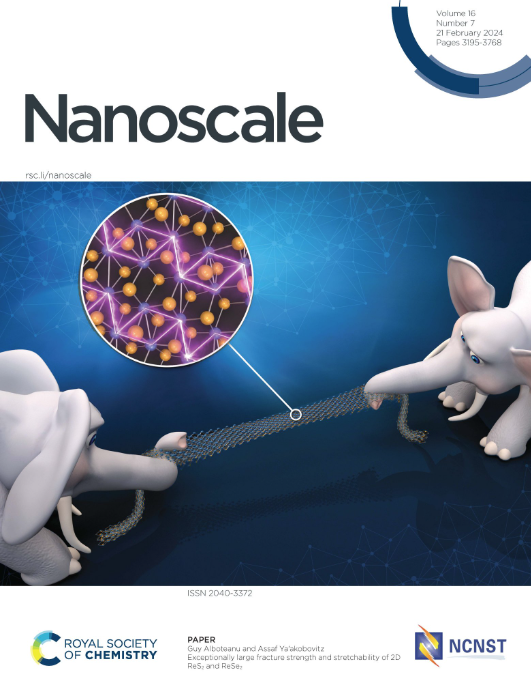In Chemico Categorization of Magnetite-, Hydroxyapatite-, and Ag-Derived Hybrid Nanobiomaterials Based on the Surface Oxidative Reactivity: Implications of Doping and Coating
IF 5.8
3区 材料科学
Q1 CHEMISTRY, MULTIDISCIPLINARY
引用次数: 0
Abstract
In chemico tests are important tools that complement in silico, in vitro and in vivo approaches to predict the toxicological impact of nanomaterials (NMs). Here, we apply a recently proposed in chemico methodology, based on the evaluation of the number, nature and properties of reactive surface sites of NMs, to a series of magentite-, hydroxyapatite- and silver-based hybrid nanobiomaterials (NBMs). The properties of the NBMs were examined using methanol chemisorption followed by temperature-programmed surface reaction (MeOH-TPSR), dithiothreitol (DTT) oxidation, cyclic voltammetry in biologically relevant media, and electronic paramagnetic resonance (EPR) spectroscopy in a series of relevant media as spin trap. The resulting data were critically compared and correlated with the available in vitro data on the NBMs’ hazard. Our findings reveal significant differences in the oxidative potential of these hybrid NBMs. Iron (Fe) doping in hydroxyapatite (HA) introduced new redox-active surface sites, leading to increased oxidative reactivity via ROS-independent mechanisms, as evidenced by higher DTT depletion and Fenton-like activity compared HA. Conversely, titanium (Ti) doping modified HA's surface by introducing acidic active sites, reducing its oxidative capacity. Coating Fe₃O₄ with poly(ethylene glycol)-poly(lactic-co-glycolic) acid (PEG-PLGA) enhanced oxidative reactivity without ROS generation, suggesting a surface-driven process. In contrast, hydroxyethyl cellulose (HEC) coating significantly reduced the high reactivity of uncoated silver (Ag). This study underscores the importance of determining the NBMs’ reactive profile for safe biomedical use, highlighting how specific coatings and dopants can transform oxidative surface properties.基于表面氧化反应性的磁铁矿、羟基磷灰石和银衍生杂化纳米生物材料的化学分类:掺杂和涂层的意义
化学试验是预测纳米材料(NMs)毒理学影响的重要工具,是对硅、体外和体内方法的补充。在此,我们将最近提出的一种化学方法应用于一系列磁铁矿、羟基磷灰石和银基杂化纳米生物材料(NBMs),该方法基于对纳米材料表面活性位点的数量、性质和性质的评估。采用甲醇化学吸附、程序升温表面反应(MeOH-TPSR)、二硫苏糖醇(DTT)氧化、生物相关介质中的循环伏安法和自旋阱等相关介质中的电子顺磁共振(EPR)光谱法研究了NBMs的性能。对所得数据进行了严格比较,并与有关NBMs危害的现有体外数据进行了关联。我们的发现揭示了这些杂交NBMs氧化电位的显著差异。羟基磷灰石(HA)中的铁(Fe)掺杂引入了新的氧化活性表面位点,通过不依赖ros的机制导致氧化反应活性增加,与羟基磷灰石相比,DTT损耗和芬顿样活性更高。相反,钛(Ti)掺杂通过引入酸性活性位点修饰HA的表面,降低其氧化能力。聚乙二醇-聚乳酸-羟基乙酸(PEG-PLGA)包覆Fe₃O₄增强了Fe₃O₄的氧化活性,但不产生ROS,表明Fe₃O₄是一个表面驱动的过程。相反,羟乙基纤维素(HEC)涂层显著降低了未涂层银(Ag)的高反应性。这项研究强调了确定NBMs的反应特性对安全生物医学用途的重要性,强调了特定涂层和掺杂剂如何改变氧化表面性质。
本文章由计算机程序翻译,如有差异,请以英文原文为准。
求助全文
约1分钟内获得全文
求助全文
来源期刊

Nanoscale
CHEMISTRY, MULTIDISCIPLINARY-NANOSCIENCE & NANOTECHNOLOGY
CiteScore
12.10
自引率
3.00%
发文量
1628
审稿时长
1.6 months
期刊介绍:
Nanoscale is a high-impact international journal, publishing high-quality research across nanoscience and nanotechnology. Nanoscale publishes a full mix of research articles on experimental and theoretical work, including reviews, communications, and full papers.Highly interdisciplinary, this journal appeals to scientists, researchers and professionals interested in nanoscience and nanotechnology, quantum materials and quantum technology, including the areas of physics, chemistry, biology, medicine, materials, energy/environment, information technology, detection science, healthcare and drug discovery, and electronics.
 求助内容:
求助内容: 应助结果提醒方式:
应助结果提醒方式:


